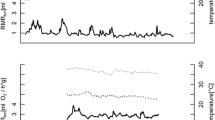Summary
Traditionally, the adaptive value of mammalian white fat stores is considered in relation to longterm needs such as providing protection against the vagaries of winter or signalling the reproductive system when energy reserves are sufficient to risk pregnancy. As shown here, the fat stores of young house mice could not serve such needs. Despite prolonged acclimation and excess nesting material, food deprivation at 10°C significantly lowered the fat stores of peripubertal female house mice in only 12 h, and would exhaust them in 30 h. Even close to thermoneutrality (24°C) the calculated time to exhaustion was only 70 h. The fat stores of a young house mouse are obviously too meager to offer any meaningful protection over a winter of several months duration, or even over a 5–6-week cycle of pregnancy and lactation. Furthermore, in a wild habitat where food availability and ambient temperature can vary rapidly and greatly, such fat stores would be too labile to effectively coordinate puberty with somatic development.
Similar content being viewed by others
References
Barnett SA (1973) Maternal processes in cold adaptation in mice. Biol Rev 40:5–51
Berry RJ (1970) The natural history of the house mouse. Field Stud 3:219–262
Berry RJ (1981) Population dynamics of the house mouse. In: Berry RJ (ed) Biology of the house mouse, Academic Press, London, pp 395–426
Bronson FH (1979) The reproductive ecology of the house mouse. Q Rev Biol 54:265–299
Bronson FH (1984) Energy allocation and reproductive development in wild and domestic house mice. Biol Repord 31:83–88
Bronson FH (1987) Susceptibility of the fat reserves of mice to natural challenges. J Comp Physiol B 157:551–554
Bronson FH, Pryor S (1983) Ambient temperature and reproductive success in rodents living in different latitudes. Biol Reprod 29:72–80
Cherry RH, Verner L (1975) Seasonal acclimatization to temperature in the prairie vole, Microtus ochrogaster. Am Midl Nat 94:354–360
Dark J, Zucker I, Wade G (1983) Photoperiodic regulation of body mass, food intake and reproduction in meadow voles. Am J Physiol 245:R334-R338
Fiest DD (1984) Metabolic and thermogenic adjustments in winter acclimatization of subarctic Alaska red-backed voles. Spec Publ Carn Mus Nat Hist 10:131–137
Frisch RE (1984) Body fat, puberty and fertility. biol Rev 59:161–188
Frisch RE (1987) Body fat, menarche, fitness and fertility. Hum Reprod 2:521–533
Gyug LW, Millar JS (1980) Fat levels in a subarctic population of Peromyscus maniculatus. Can J Zool 58:1341–1346
Hart JS (1971) Rodents. In: Whittow GC (ed) Comparative physiology of thermoregulation. Academic Press, New York, Vol 2, pp 1–49
Heller HC, Musacchia XJ, Wang LCH (eds) (1986) Living in the cold Elsevier Press, Amsterdam, p 382
Howard WE (1951) Relation between low temperature and available food to survival of small rodents. J Mammal 32:3–312
Hudson RJ, White RG (eds) (1985) Bioenergetics of wild herbivores. CRC Press, Inc. Boca Raton, Fla, p 314
Judd FW, Herrera J, Wagner M (1978) The relationship between lipid and reproductive cycles of a subtropical population of Peromyscus leucopus. J Mammal 59:669–676
Laurie EMO (1946) The reproduction of the house mouse (Mus musculus) living in different environments. Proc R Soc Lond B 133:248–281
Lidicker WZ (1975) The role of dispersal in the demography of small mammals. In: Golley FB, Petrusewicz K, Ryszkowski I (eds) Small mammals: their productivity: population dynamics. Cambridge University Press, pp 103–128
Lynch GR, Gendler SL (1980) Multiple responses to a short-day photoperiod occur in the mouse Peromyscus leucopus. Oecologia 45:318–321
Merson MH, Kirkpatrick RL (1983) Role of energy intake in the maintenance of reproduction in female white-footed mice Peromyscus leucopus. Am Mid Nat 109:206–208
Millar JS (1989) Energy reserves in breeding small rodents. In: Loudon ASI, Racey PA (eds) Reproductive energetics in mammals. Oxford Scientific Publishers, pp 231–240
Morton ML, Lewis RA (1980) Annual changes in blood parameters, organ weights and total body lipid in Peromyscus maniculatus and Microtus ochrogaster from a prairie environment. J Interdiscipl Cycle Res 11:209–218
Pelikan J (1981) Patterns of reproduction in the house mouse. In: Biology of the house mouse. Symposia of the Zoological Society of London 47:205–229
Perrin MR (1981) Seasonal changes in the body fat content of two coexisting rodents, Rhabdomys pumilio and Otomys irroratus. South Afr J Wildl Res 11:21–27
Pond CM (1978) Morphological aspects and the ecological and mechanical consequences of fat deposition in wild vertebrates. Ann Rev Ecol Syst 9:519–570
Quay WB (1984) Winter tissue changes and regulatory mechanisms in non-hibernating small mammals: a survey and evaluation of adaptive and non-adaptive features. Spec Publ Carn Mus Nat Hist 10:149–163
Schneider JE, Wade GN (1989) Availability of metabolic fuels controls estrous cyclicity of Syrian hamsters. Science 244:1326–1328
Wickler SJ (1981) Seasonal changes in enzymes of aerobic heat production in the white-footed mouse. Am J Physiol 210:R289-R294
Wunder BA (1984) Strategies for, and environmental cueing mechanisms of, seasonal changes in thermoregulatory parameters of small mammals. Spec Publ Carn Mus Nat Hist 10:165–172




